Optimal Design of Power-Split HEVs Based on Total Cost of Ownership and CO2 Emission Minimization
Abstract
:1. Introduction
1.1. State-Of-The-Art on the Optimal Design for Hybrid Electric Vehicles
1.2. Contribution of the Present Study
1.2.1. Optimal Design tool for HEVs
1.2.2. Application of the Tool to Three Different Hybrid Vehicles Equipped with a Power-Split Layout
1.2.3. Cost-Benefit Analysis
- (1)
- A diesel hybrid vehicle is extremely advantageous in terms of CO2 emission reduction. Average CO2 emissions from new cars in Europe have increased in the last few years [29], also as a consequence of a fall in the market share for diesel vehicles. This makes it hard, for car manufacturers, to achieve the required EU average fleet target of 95 gCO2/km by 2021 for new vehicles.
- (2)
- It is true that a diesel hybrid vehicle leads to high initial costs compared to a gasoline HEV. Still, one should be considered that the cost of diesel oil is generally lower than that of gasoline. Moreover, the efficiency of diesel engines is higher than that of gasoline engines. As a consequence, the initial additional cost may be counterbalanced by the lower operating costs. A recent study by University of Michigan [30] shows that clean diesel engines in conventional vehicles provide a return in investment in a timeframe ranging around 3–5 years.
- (3)
- The hybridization of a diesel vehicle may lead to advantages in terms of pollutant emission control (see [31]) and combustion noise control, thanks to the possibility of optimizing the power flow of the powertrain. Therefore, this could make the diesel vehicle more environmentally friendly. Moreover, the possibility of controlling pollutant emissions by means of power flow optimization may lead to a lighter after-treatment system, with advantages in terms of costs.
- (4)
- Although the current social and political attitude towards diesel is negative, recently developed diesel powertrains have proved to emit no more than 13 mg/NOx per kilometer (far less than European standards after 2020), also exploiting artificial intelligence [32].
2. Vehicle Model
2.1. HEV Layouts and Vehicle Class Segments
2.2. Control/State Variables and Their Discretization
- (1)
- The transmission speed ratio, .
- (2)
- The power flow (PF) through the engine, the two electric machines and the battery.
3. Optimal Control Strategy
3.1. Objective Function
3.2. Dynamic Programming
4. Optimal Vehicle Design
4.1. Toolbox
4.2. Vehicle Performance Constraint
- (1)
- The maximum vehicle velocity over a flat road has to exceed the target value, which depends on the vehicle class.
- (2)
- The times required by the vehicle to accelerate from 0 to 50 km/h, from 0 to 100 km/h, from 65 to 100 km/h and from 80 to 110 km/h over a flat road have to be lower than the corresponding target values.
- (3)
- The maximum power that the powertrain can provide at 80 km/h has to exceed the power demand of the vehicle at that given velocity over a 7.2% uphill road, as a gradeability requirement;
- (4)
- The vehicle is required to tow a trailer of total mass .
- (5)
- The vehicle has to accelerate up to 30 km/h over an uphill road which slope is defined by .
- (6)
- The cumulated engine-out NOx mass emissions of the hybrid vehicle over each mission has to be smaller than the cumulated mass of the conventional vehicle.
4.3. Definition of the Total Cost of Ownership and of the Manufacturer Suggested Retail Price
5. Model Validation and Driving Mission Specifications
5.1. Validation of the Vehicle Model
5.2. Specifications of the Considered Driving Missions
6. Results and Discussion
6.1. Vehicle Design
6.1.1. Optimal Design: Cost-Benefit Analysis
6.1.2. Impact of the Driving Mission Selection on the Optimal Vehicle Design
6.1.3. Impact of the Design Components on the Costs and Benefits
6.2. Vehicle Cost Analysis
6.3. Sensitivity Analysis
6.3.1. Objective Function Definition
6.3.2. Discretization of the Power-Flow Domain
6.4. Cost Premium and Break-Even Fuel Price
7. Conclusions and Future Work
7.1. Optimal Design and Vehicle Performance
7.2. Sensitivity Analysis
7.3. Cost Premium and Break-Even Analysis
7.4. Next Steps
Author Contributions
Funding
Acknowledgments
Conflicts of Interest
Abbreviations
| α | Power Flow sub-control variable to manage the engine power |
| αroad | uphill road slope for the 5th vehicle performance target |
| β1/2 | Weighting factors in the objective function |
| χ | Power Flow sub-control variable to manage the power split during pure electric mode |
| δ | e-CVT speed ratio |
| τ | Transmission speed ratio |
| τfd | Final drive speed ratio |
| τgb | Single-speed gearbox speed ratio |
| τpg | Planetary gear set speed ratio |
| ρfuel | Fuel density (kg/L) |
| 1015 | Japanese 10–15 mode driving cycle |
| 3gTR | Power-split layout with a 3-gear transmission |
| AMDC | Artemis Motorway Driving Cycle |
| BEFP | Break-Even Fuel Price ($/kg) |
| BEV | Battery Electric Vehicle |
| BP | Battery Price |
| BU | Battery Usage |
| C | Cost ($) |
| CBF | Cost Benefit Factor ($/(g/km)) |
| CO2 | Carbon dioxide |
| CV | Conventional Vehicle |
| D0 | 130 kW diesel engine |
| D1 | 97 kW diesel engine |
| D2 | 70 kW diesel engine |
| DP | Dynamic Programming |
| eCVT | electric Continuously Variable Transmission |
| E | Energy (J) |
| EM | Electric Machine |
| E_REV | Extended Range Electric Vehicle |
| FC | Fuel Consumption |
| FD | Final Drive |
| FP | Fuel Price |
| GB | Gear Box |
| HEV | Hybrid Electric Vehicle |
| J | Objective Function |
| MSRP | Manufacturer’s Suggested Retail Price |
| NEDC | New European Driving Cycle |
| Ny | Lifetime of the vehicle (year) |
| noTR | Power-split layout with no transmission |
| NOx | Nitrogen oxides |
| OEM | Original Equipment Manufacturer |
| Pb,max | Maximum battery power (W) |
| Pe,max | Maximum engine power (W) |
| Pem1/2 | Maximum electric machine power (W) |
| PBF | Price Benefit Factor ($/(g/km)) |
| PEb | Power-to-Energy ratio of the battery |
| PF | Power Flow |
| PG | Planetary Gear |
| PHEV | Plug-in Hybrid Electric Vehicle |
| rn | Discount rate (%) |
| SOC | State of Charge |
| SUV | Sport Utility Vehicle |
| TCO | Total Cost of Ownership |
| u | Control strategy |
| VKT | Vehicle Kilometers of Travel |
Appendix A
Appendix A.1. Weight Model of the Engine, the Electric Machine, the Battery and the Driveline
Appendix A.2. Vehicle Model Equations: Determination of the Power and Speed of the Engine and Electric Machines
Appendix A.3. Evaluation of the Production and Operating Costs of the Vehicle
Appendix A.3.1. Production Cost
Appendix A.3.2. Operating Costs
References
- Huang, K.D.; Quang, K.V.; Tseng, K.T. Study of the effect of contraction of cross-sectional area on flow energy merger in hybrid pneumatic power system. Appl. Energy 2009, 86, 2171–2182. [Google Scholar] [CrossRef]
- Un-Noor, F.; Padmanaban, S.; Mihet-Popa, L.; Mollah, M.N.; Hossain, E. A Comprehensive Study of Key Electric Vehicle (EV) Components, Technologies, Challenges, Impacts, and Future Direction of Development. Energies 2017, 10, 1217. [Google Scholar] [CrossRef]
- Damiani, L.; Repetto, M.; Prato, A.P. Improvement of powertrain efficiency through energy breakdown analysis. Appl. Energy 2014, 121, 252–263. [Google Scholar] [CrossRef]
- Saxena, S.; Phadke, A.; Gopal, A. Understanding the fuel savings potential from deploying hybrid cars in China. Appl. Energy 2014, 113, 1127–1133. [Google Scholar] [CrossRef]
- Zhang, S.; Wu, Y.; Liu, H.; Huang, R.; Yang, L.; Li, Z.; Hao, J. Real-world fuel consumption and CO2 emissions of urban public buses in Beijing. Appl. Energy 2014, 113, 1645–1655. [Google Scholar] [CrossRef]
- Hutchinson, T.; Burgess, S.; Herrmann, G. Current hybrid-electric powertrain architectures: Applying empirical design data to life cycle assessment and whole-life cost analysis. Appl. Energy 2014, 119, 314–329. [Google Scholar] [CrossRef] [Green Version]
- Tate, E.; Harpster, M.; Savagian, P. The Electrification of the Automobile: From Conventional Hybrid, to Plug-in Hybrids, to Extended-Range Electric Vehicles. SAE Int. J. Passeng. Cars Electron. Electr. Syst. 2009, 1, 156–166. [Google Scholar] [CrossRef]
- Du, J.; Yang, F.; Cai, Y.; Du, L.; Ouyang, M. Testing and Analysis of the Control Strategy of Honda Accord Plug-in HEV. IFAC PapersOnLine 2016, 49, 153–159. [Google Scholar] [CrossRef]
- Khan, A.; Grewe, T.; Liu, J.; Anwar, M.; Holmes, A.; Baisley, R. The GM RWD PHEV Propulsion System for the Cadillac CT6 Luxury Sedan; SAE Technical Paper 2016-01-1159; SAE International: Warrendale, PA, USA, 2016. [Google Scholar] [CrossRef]
- Wu, X.; Dong, J.; Lin, Z. Cost analysis of plug-in hybrid electric vehicles using GPS-based longitudinal travel data. Energy Policy 2014, 68, 206–217. [Google Scholar] [CrossRef]
- Tanoue, K.; Yanagihara, H.; Kusumi, H. Hybrid is key Technology for Future Automobiles. In Hydrogen Technology; Léon, A., Ed.; Green Energy and Technology; Springer: Berlin/Heidelberg, Germany, 2008; pp. 235–272. ISBN 978-3-540-79027-3. [Google Scholar] [CrossRef]
- Yang, Y.; Emadi, A. Integrated electro-mechanical transmission systems in hybrid electric vehicles. In Proceedings of the 2011 IEEE Vehicle Power and Propulsion Conference, Chicago, IL, USA, 6–9 September 2011. [Google Scholar] [CrossRef]
- Yang, Y.; Schofield, N.; Emadi, A. Integrated Electromechanical Double-Rotor Compound Hybrid Transmissions for Hybrid Electric Vehicles. IEEE Trans. Veh. Technol. 2016, 65, 4687–4699. [Google Scholar] [CrossRef]
- Miller, J.M. Hybrid electric vehicle propulsion system architectures of the e-CVT type. IEEE Trans. Power Electron. 2006, 21, 756–767. [Google Scholar] [CrossRef] [Green Version]
- Kapadia, J.; Kok, D.; Jennings, M.; Kuang, M.; Masterson, B.; Isaacs, R.; Dona, A.; Wagner, C.; Gee, T. Powersplit or Parallel-Selecting the Right Hybrid Architecture. SAE Int. J. Altern. Powertrains 2017, 6, 68–76. [Google Scholar] [CrossRef]
- Matthè, R.; Eberle, U. The Voltec System—Energy Storage and Electric Propulsion. In Lithium-Ion Batteries: Advances and Applications; Elsevier: New York, NY, USA, 2014; pp. 151–176. ISBN 978-044459513-3. [Google Scholar] [CrossRef]
- Wu, X.; Cao, B.; Li, X.; Xu, J.; Ren, X. Component sizing optimization of plug-in hybrid electric vehicles. Appl. Energy 2011, 88, 799–804. [Google Scholar] [CrossRef]
- Jain, M.; Desai, C.; Williamson, S.S. Genetic algorithm based optimal powertrain component sizing and control strategy design for a fuel cell hybrid electric bus. In Proceedings of the 2009 IEEE Vehicle Power and Propulsion Conference, Dearborn, MI, USA, 7–10 September 2009. [Google Scholar] [CrossRef]
- Kim, M.J.; Peng, H. Power management and design optimization of fuel cell/battery hybrid vehicles. J. Power Sources 2007, 165, 819–832. [Google Scholar] [CrossRef] [Green Version]
- Paladini, V.; Donateo, T.; De Risi, A.; Laforgia, D. Super-capacitors fuel-cell hybrid electric vehicle optimization and control strategy development. Energy Convers. Manag. 2007, 48, 3001–3008. [Google Scholar] [CrossRef]
- Shiau, C.S.N.; Kaushal, N.; Hendrickson, C.T.; Peterson, S.B.; Whitacre, J.F.; Michalek, J.J. Optimal plug-in hybrid electric vehicle design and allocation for minimum life cycle cost, petroleum consumption, and greenhouse gas emissions. J. Mech. Des. 2010, 132, 091013. [Google Scholar] [CrossRef]
- Zhou, X.; Qin, D.; Hu, J. Multi-objective optimization design and performance evaluation for plug-in hybrid electric vehicle powertrains. Appl. Energy 2017, 208, 1608–1625. [Google Scholar] [CrossRef]
- Dimitrova, Z.; Maréchal, F. Techno-economic design of hybrid electric vehicles using multi objective optimization techniques. Energy 2015, 91, 630–644. [Google Scholar] [CrossRef] [Green Version]
- Guo, H.; Sun, Q.; Wang, C.; Wang, Q.; Lu, S. A systematic design and optimization method of transmission system and power management for a plug-in hybrid electric vehicle. Energy 2018, 148, 1006–1017. [Google Scholar] [CrossRef]
- Fathy, H.K.; Reyer, J.A.; Papalambros, P.Y.; Ulsov, A.G. On the coupling between the plant and controller optimization problems. In Proceedings of the 2001 American Control Conference, Arlington, VA, USA, 25–27 June 2001. [Google Scholar] [CrossRef]
- Finesso, R.; Spessa, E.; Venditti, M. Layout design and energetic analysis of a complex diesel parallel hybrid electric vehicle. Appl. Energy 2014, 134, 573–588. [Google Scholar] [CrossRef]
- Finesso, R.; Spessa, E.; Venditti, M. Cost-optimized design of a dual-mode diesel parallel hybrid electric vehicle for several driving missions and market scenarios. Appl. Energy 2016, 177, 366–383. [Google Scholar] [CrossRef]
- Bellman, R.; Kalaba, R.E. Dynamic Programming and Modern Control Theory, 1st ed.; Academic Press: New York, NY, USA, 1966; ISBN 9780120848560. [Google Scholar]
- CO2 Emissions Rise for the First Time in a Decade in Europe, as the Market Turns Its Back on Diesel Vehicles and SUV Registrations Rise. Available online: http://www.jato.com/co2-emissions-rise-first-time-decade-europe-market-turns-back-disel-vehicles-suv-registrations-rise/ (accessed on 12 June 2018).
- Belzowski, B.M. Total Cost of Ownership: A Diesel Versus Gasoline Comparison (2012–2013). Record of the Transportation Research Institute (UMTRI), 2015. Available online: https://deepblue.lib.umich.edu/bitstream/handle/2027.42/111893/103193.pdf?sequence=1&isAllowed=y (accessed on 12 June 2018).
- Grondin, O.; Thibault, L.; Quérel, C. Energy Management Strategies for Diesel Hybrid Electric Vehicle. Oil Gas Sci. Technol. 2015, 70, 125–141. [Google Scholar] [CrossRef]
- Breakthrough: New Bosch Diesel Technology Provides Solution to NOx Problem. Available online: https://www.bosch-presse.de/pressportal/de/en/breakthrough-new-bosch-diesel-technology-provides-solution-to-nox-problem-155524.html/ (accessed on 12 June 2018).
- Moawad, A.; Sharer, P.; Rousseau, A. Light-Duty Vehicle Fuel Consumption Displacement Potential up to 2045; Report No. ANL/ESD/11-4; Argonne National Laboratory (ANL): Lemont, IL, USA, 2014. Available online: https://anl.box.com/s/3gq9mxqu49odm2vs14jzsnn0hompwxnu (accessed on 12 June 2018).
- Bellman, R.; Lee, E. History and development of dynamic programming. IEEE Control Syst. Mag. 1984, 4, 24–28. [Google Scholar] [CrossRef]
- Finesso, R.; Spessa, E.; Venditti, M. Optimization of the Layout and Control Strategy for Parallel Through-the-Road Hybrid Electric Vehicles; SAE Technical Paper 2014-01-1798; SAE International: Warrendale, PA, USA, 2016. [Google Scholar] [CrossRef]
- Graham, R. Comparing the Benefits and Impacts of Hybrid Electric Vehicle Options; Technical Report No. 1000349; Electric Power Research Institute (EPRI): Palo Alto, CA, USA, 2001; Available online: http://citeseerx.ist.psu.edu/viewdoc/download?doi:10.1.1.469.1443&rep=rep1&type=pdf (accessed on 12 June 2018).
- Catania, A.E.; Finesso, R.; Spessa, E. Predictive zero-dimensional combustion model for DI diesel engine feed-forward control. Energy Convers. Manag. 2011, 52, 3159–3175. [Google Scholar] [CrossRef]
- Morra, E.P.; Spessa, E.; Venditti, M. Optimization of the operating strategy of a bas hybrid diesel powertrain on type-approval and real-world representative driving cycles. In Proceedings of the ASME 2012 Internal Combustion Engine Division Spring Technical Conference, Torino, Italy, 6–9 May 2012; American Society of Mechanical Engineers: New York, NY, USA, 2012. [Google Scholar] [CrossRef]
- Morra, E.P.; Spessa, E.; Ciaravino, C.; Vassallo, A. Analysis of various operating strategies for a parallel-hybrid diesel powertrain with a belt alternator starter. SAE Int. J. Altern. Powertrains 2012, 1, 231–239. [Google Scholar] [CrossRef]
- Finesso, R.; Spessa, E.; Venditti, M. An Unsupervised Machine-Learning Technique for the Definition of a Rule-Based Control Strategy in a Complex HEV. SAE Int. J. Altern. Powertrains 2016, 5, 308–327. [Google Scholar] [CrossRef]
- Serrao, L.; Onori, S.; Sciarretta, A.; Guezennec, Y.; Rizzoni, G. Optimal energy management of hybrid electric vehicles including battery aging. In Proceedings of the 2011 American Control Conference, San Francisco, CA, USA, 29 June–1 July 2011. [Google Scholar] [CrossRef]
- Delucchi, M.; Burke, A.; Lipman, T.; Miller, M. Electric and Gasoline Vehicle Lifecycle Cost and Energy-Use Model; Report for the California Air Resources Board; Report No. UCD-ITS-RR-99-4; Institute of Transportation Studies: Irvine, CA, USA, 2000; Available online: https://escholarship.org/uc/item/1np1h2zp (accessed on 12 June 2018).
- Simpson, A. Cost-Benefit Analysis of Plug-In Hybrid Electric Vehicle Technology. Presented at the 22nd International Battery, Hybrid and Fuel Cell Electric Vehicle Symposium and Exhibition, Yokohama, Japan, 23–28 October 2006; National Renewable Energy Laboratory: Golden, CO, USA, 2006. Available online: https://digital.library.unt.edu/ark:/67531/metadc890581/m2/1/high_res_d/894986.pdf (accessed on 12 June 2018).

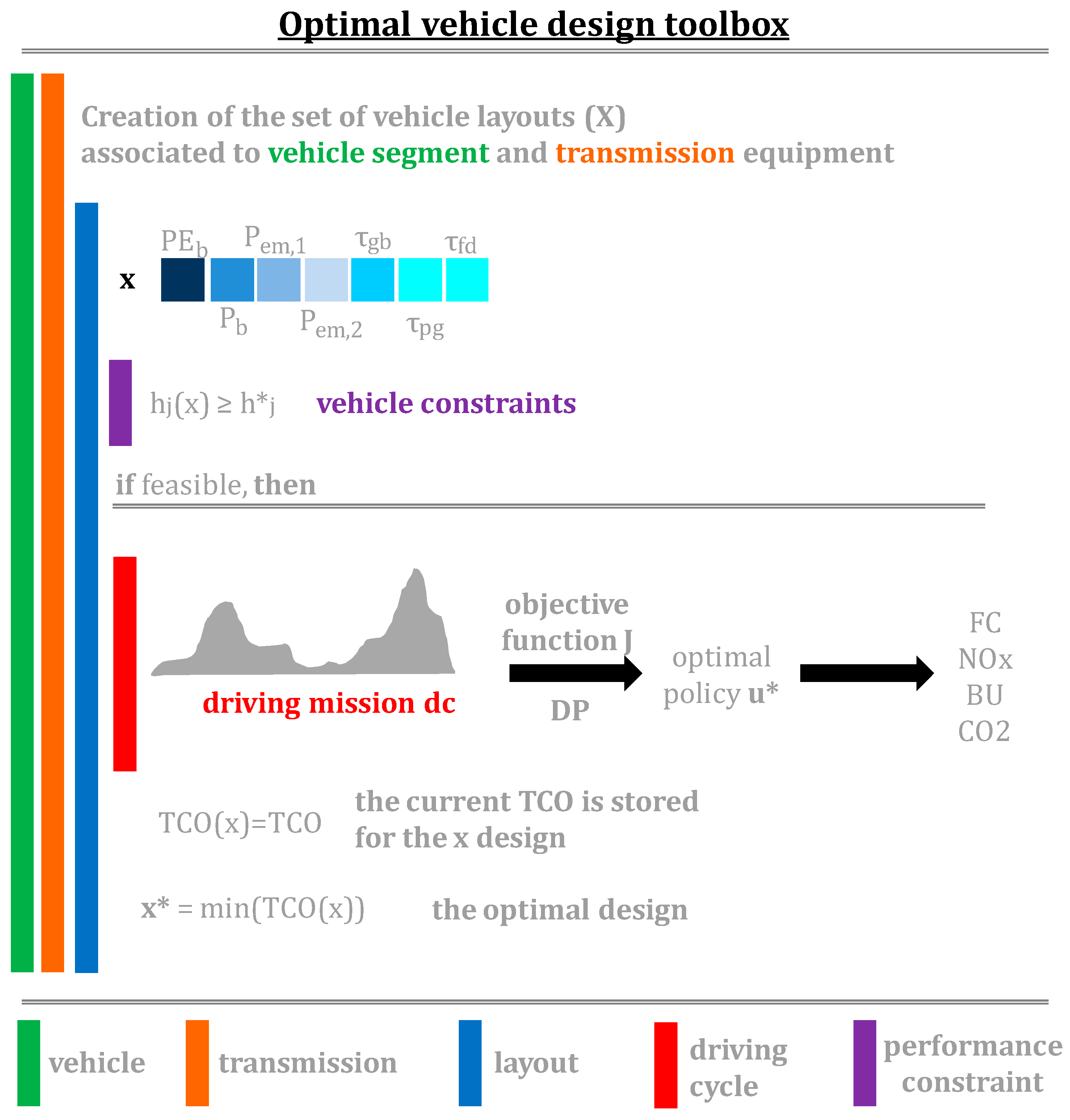
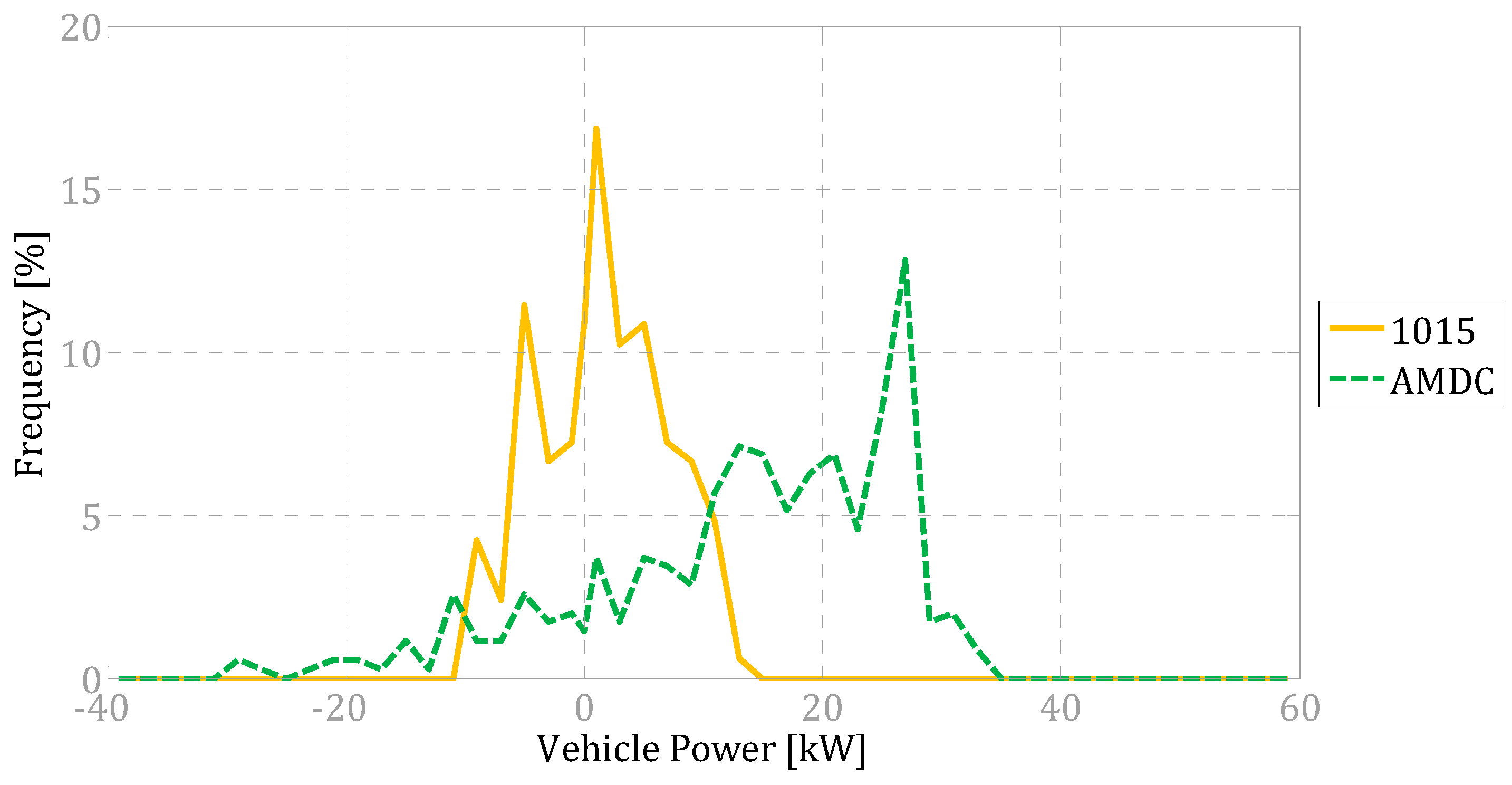
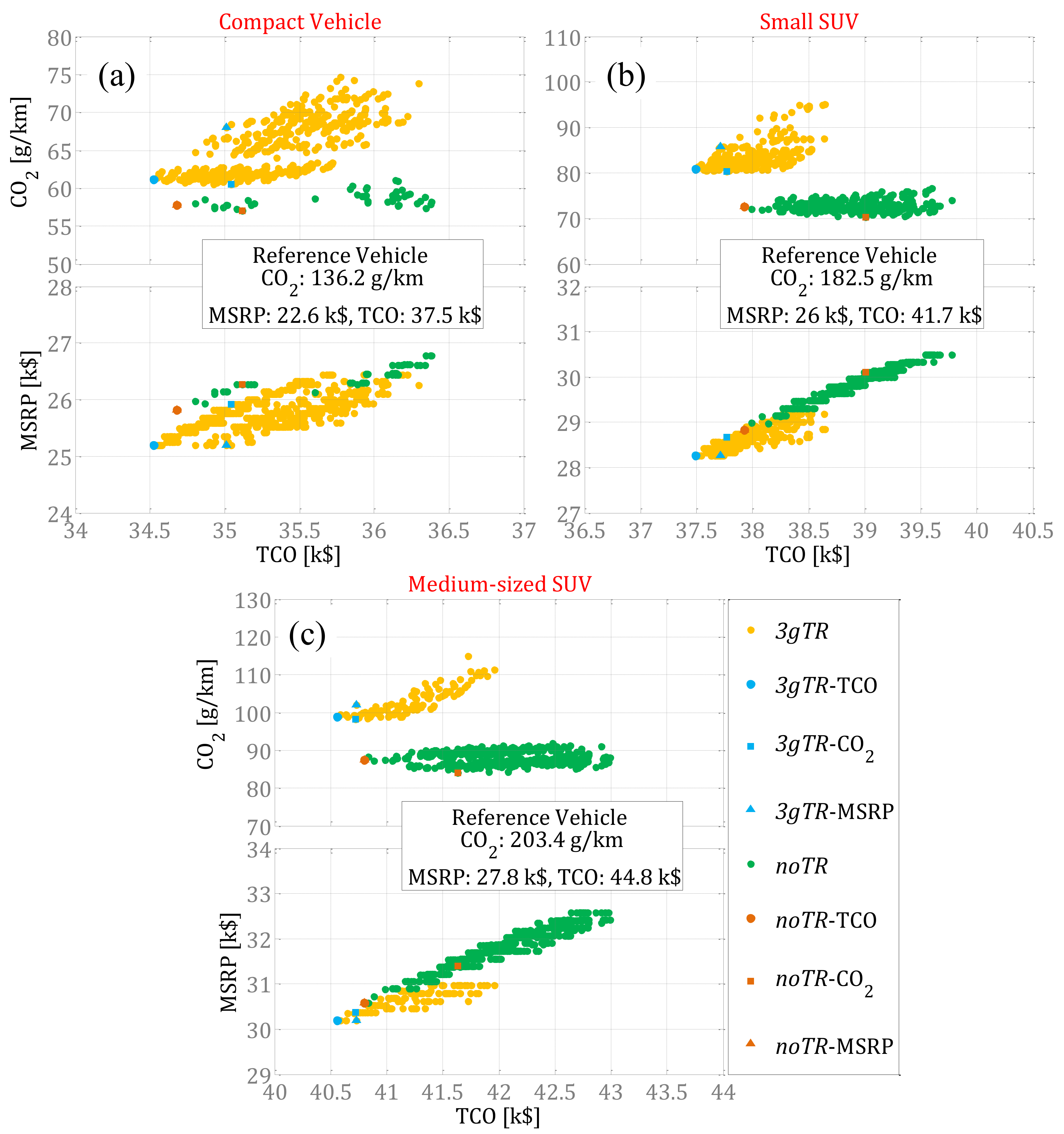
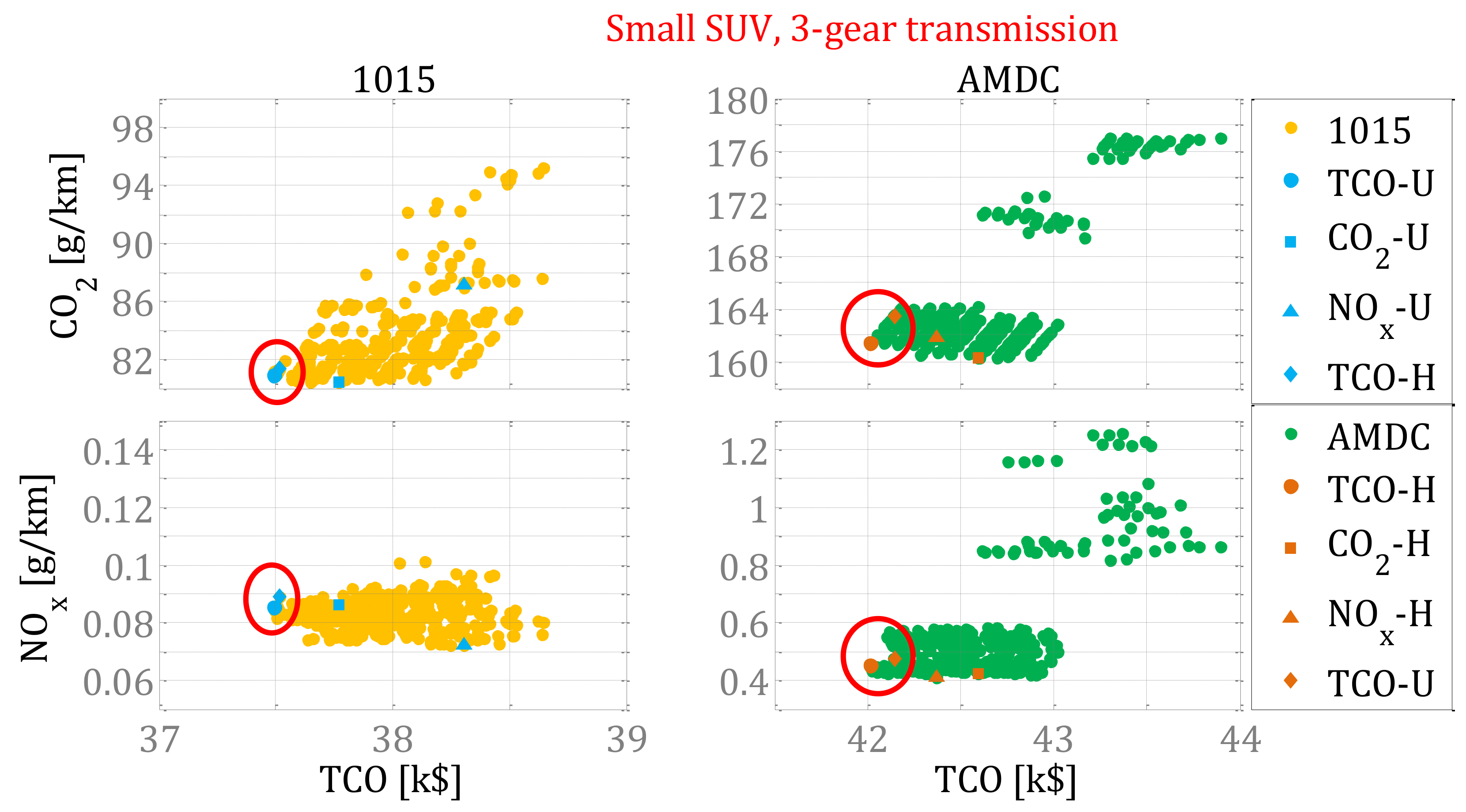
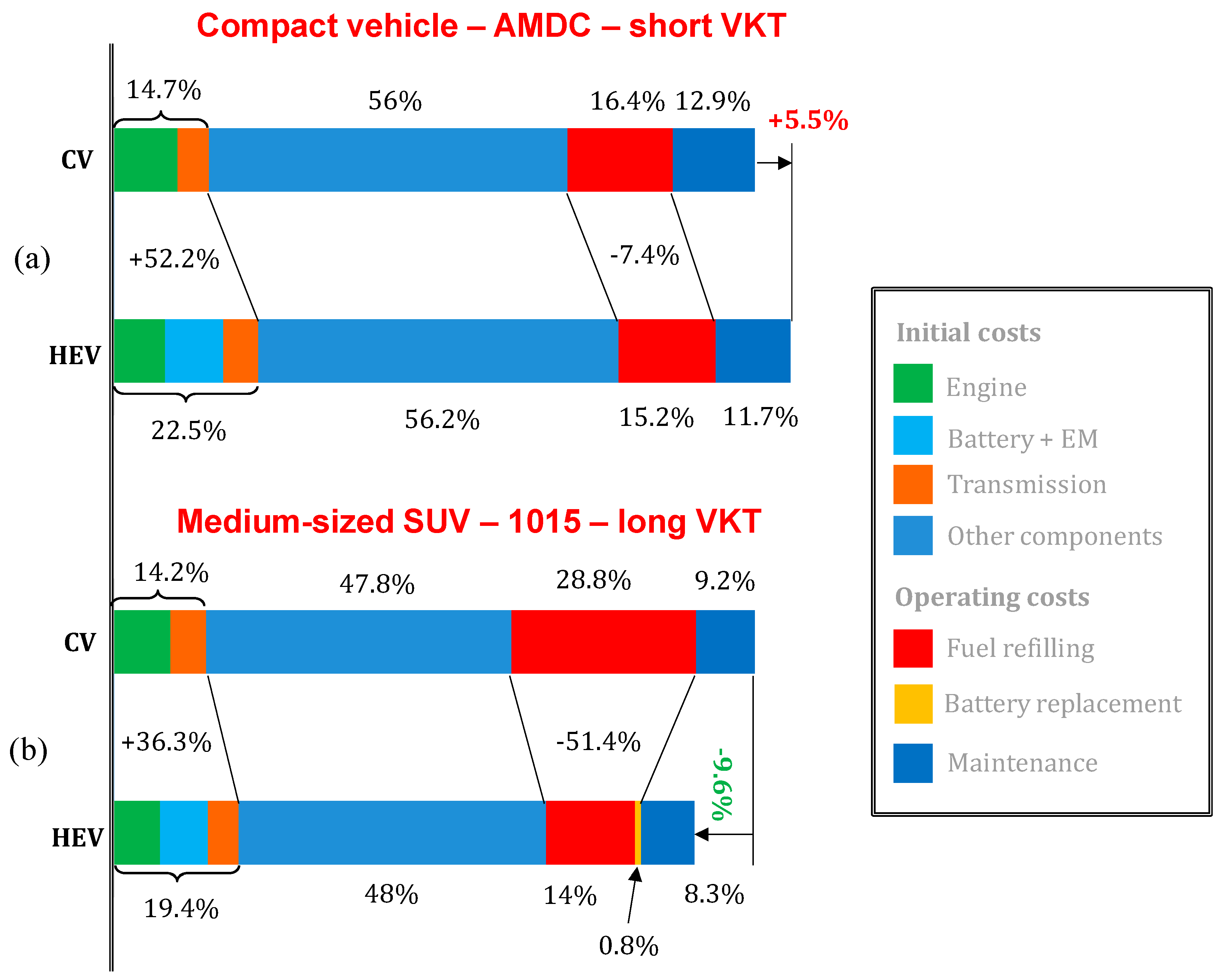
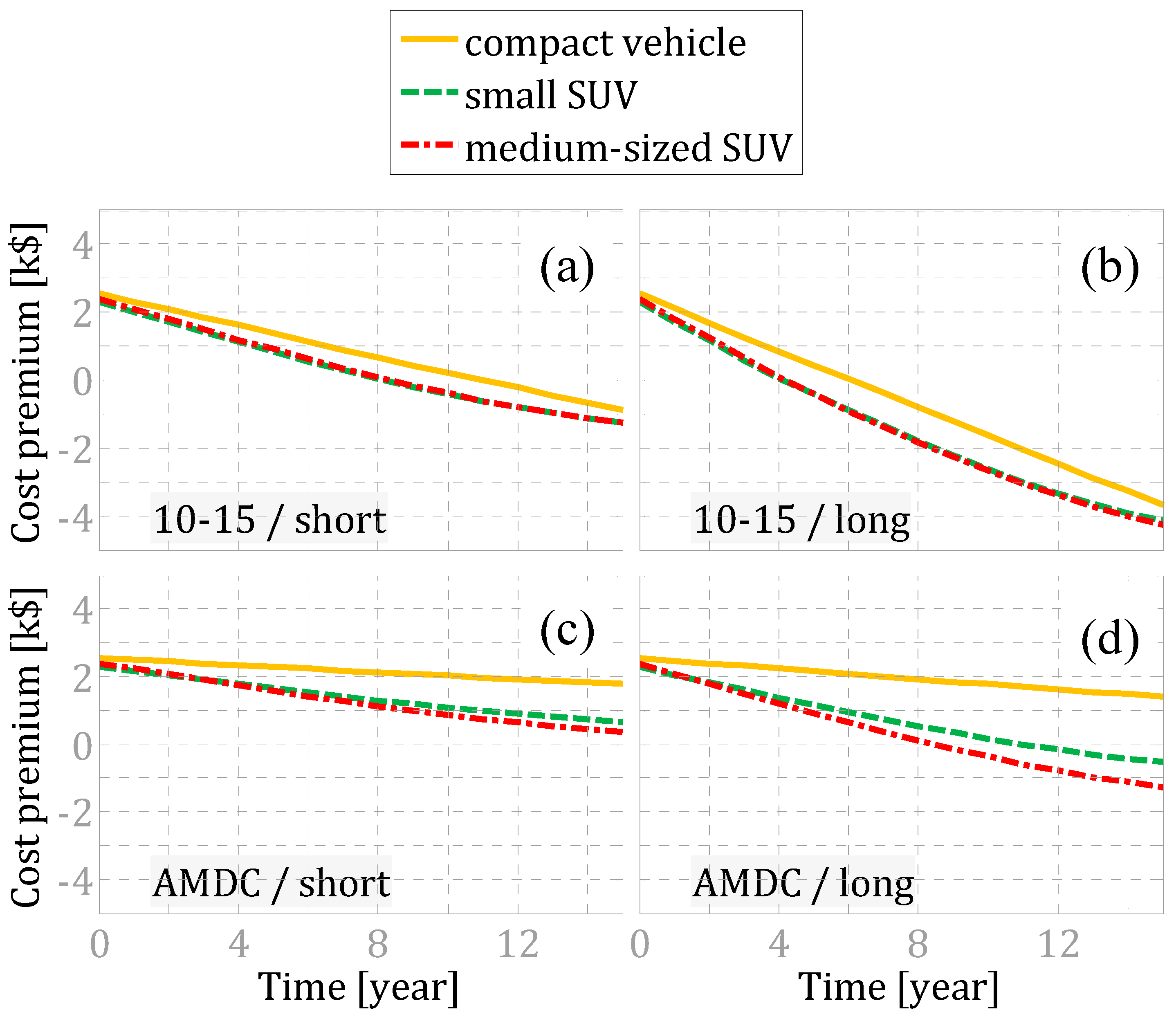

| Transmission | 1 | 2 | 3 | 4 | 5 | 6 |
|---|---|---|---|---|---|---|
| 6-speed | 4.17 | 2.13 | 1.32 | 0.95 | 0.75 | 0.62 |
| 3-speed | 3.06 | 1.53 | 0.765 |
| Engine | Displacement (L) | Max. Power (kW) | Max. Torque (Nm) |
|---|---|---|---|
| D0 | 2.9 | 130 @4000 rpm | 356 @1500 rpm |
| D1 | 1.7 | 97 @3700 rpm | 304 @2400 rpm |
| D2 | 1.3 | 70 @4000 rpm | 206 @1800 rpm |
| LayoutClass | Compact Vehicle | Small SUV | Medium-Sized SUV |
|---|---|---|---|
| Conventional | D1 | D0 | D0 |
| noTR power-split | D2 | D1 | D1 |
| 3gTR power-split | D2 | D1 | D1 |
| Specification | Compact Vehicle | Small SUV | Medium-Sized SUV |
|---|---|---|---|
| chassis mass [kg] | 800 | 1000 | 1270 |
| frontal area [m2] | 2.19 | 2.57 | 2.93 |
| drag resistance coefficient [-] | 0.27 | 0.36 | 0.38 |
| tire radius [m] | 0.317 | 0.359 | 0.367 |
| Sub-Control Variable | Value #1 | Value #2 | Value #3 | Value #4 | Value #5 | N |
|---|---|---|---|---|---|---|
| 0.5 | 1 | 1.5 | 3 | |||
| 1 | 1.25 | 1.5 | 1.75 | 2 | 5 | |
| 1 | 0 | 0.25 | 0.5 | 0.75 | 5 |
| Target | Compact Vehicle | Small SUV | Medium-Sized SUV |
|---|---|---|---|
| Maximum velocity [km/h] | 190 | 190 | 180 |
| Acceleration 0–50 km/h [s] | 4.5 | 4 | 5 |
| Acceleration 0–100 km/h [s] | 11 | 10.5 | 12 |
| Acceleration 65–100 km/h [s] | 5 | 5 | 5.5 |
| Acceleration 80–110 km/h [s] | 5.5 | 5.5 | 6 |
| Tow mass, , [kg] | 1500 | 1500 | 1500 |
| [%] | 20 | 15 | 10 |
| T (s) | D (km/h) | (kWh) | (kWh) | (km/h) | (kW) | |
|---|---|---|---|---|---|---|
| 1015 | 660 | 4.17 | 0.37 | −0.20 | 31.65 | 4.71 |
| AMDC | 1068 | 29.36 | 4.33 | −0.59 | 100.1 | 17.74 |
| Class | Layout | Mass (kg) | Power-To-Mass (W/kg) | 0–50 km/h Time (s) | 0–100 km/h Time (s) |
|---|---|---|---|---|---|
| Compact | CV | 1345 | 62.89 | 4.15 | 10.05 |
| noTR | 1265.1 | 69.7 | 4.45 | 10.7 | |
| 3gTR | 1266.9 | 58.1 | 3.35 | 9.8 | |
| Small SUV | CV | 1630 | 69.9 | 3.45 | 9.3 |
| noTR | 1525.7 | 80.7 | 4 | 10.4 | |
| 3gTR | 1531.8 | 66.6 | 3.25 | 9.1 | |
| Medium SUV | CV | 1900 | 59.9 | 4 | 10.95 |
| noTR | 1795.7 | 63.1 | 4.85 | 11.95 | |
| 3gTR | 1805.2 | 56.6 | 3.5 | 10.3 |
| CO2 (%) | TCO (%) | MSRP (%) | ||
|---|---|---|---|---|
| Compact vehicle | 3gTR-TCO | 55.1 | 9.6 | 11.2 |
| 3gTR-CO2 | 55.5 | 8.3 | 14.4 | |
| 3gTR-MSRP | 50.0 | 8.3 | 11.2 | |
| noTR-TCO | 57.6 | 9.2 | 14.0 | |
| noTR-CO2 | 58.1 | 8.0 | 16.0 | |
| noTR-MSRP | 57.6 | 9.2 | 14.0 | |
| Small SUV | 3gTR-TCO | 55.7 | 10 | 8.8 |
| 3gTR-CO2 | 55.9 | 9.3 | 10.4 | |
| 3gTR-MSRP | 53 | 9.5 | 8.8 | |
| noTR-TCO | 60.2 | 8.9 | 11 | |
| noTR-CO2 | 61.5 | 6.3 | 15.9 | |
| noTR-MSRP | 60.2 | 8.9 | 11 | |
| Medium-sized SUV | 3gTR-TCO | 51.4 | 9.5 | 8.6 |
| 3gTR-CO2 | 51.7 | 9.1 | 9.2 | |
| 3gTR-MSRP | 50 | 9.1 | 8.6 | |
| noTR-TCO | 57 | 8.9 | 9.9 | |
| noTR-CO2 | 58.7 | 7.1 | 12.9 | |
| noTR-MSRP | 57 | 8.9 | 9.9 |
| CO2 | TCO | MSRP | CBF | PBF | ||
|---|---|---|---|---|---|---|
| (%) | (%) | (%) | ($/(g/km)) | ($/(g/km)) | ||
| Compact vehicle | 3gTR-CO2 | 0.9 | 1.5 | 2.9 | 1290.3 | 916.3 |
| 3gTR-MSRP | −11.4 | 1.4 | 0 | - | −70.2 | |
| noTR-TCO | 5.4 | 0.5 | 2.5 | 188.9 | 46.5 | |
| noTR-CO2 | 6.7 | 1.7 | 4.3 | 264.4 | 145.7 | |
| noTR-MSRP | 5.4 | 0.5 | 2.5 | 188.9 | 46.5 | |
| Small SUV | 3gTR-CO2 | 0.7 | 0.7 | 1.4 | 770 | 528.5 |
| 3gTR-MSRP | −5.9 | 0.6 | 0 | 0 | −46.4 | |
| noTR-TCO | 10.2 | 1.2 | 2 | 68.4 | 52.8 | |
| noTR-CO2 | 13.2 | 4.1 | 6.5 | 172.5 | 142 | |
| noTR-MSRP | 10.2 | 1.2 | 2 | 68.4 | 52.8 | |
| Medium-sized SUV | 3gTR-CO2 | 0.6 | 0.4 | 0.6 | 288.6 | 271.2 |
| 3gTR-MSRP | −3.2 | 0.4 | 0.0 | 0.0 | −52.3 | |
| noTR-TCO | 11.6 | 0.6 | 1.2 | 32.7 | 21.0 | |
| noTR-CO2 | 15.0 | 2.6 | 4.0 | 80.6 | 72.5 | |
| noTR-MSRP | 11.6 | 0.6 | 1.2 | 32.7 | 21.0 |
| k | 0 | 1 | 2 | 3 | 4 | 5 | 6 | 7 |
|---|---|---|---|---|---|---|---|---|
| TCO | 38535 | −24.37 | 17.95 | 43.73 | 0 | −80.31 | −34.24 | −154.2 |
| CO2 | 104.34 | −0.0023 | −0.0415 | 0.142 | 0 | −2.453 | −0.683 | −2.568 |
| Specification | Compact Vehicle | Small SUV | Medium-Sized SUV | |||
|---|---|---|---|---|---|---|
| 3-Gear transmission | ✓ | ✗ | ✓ | ✗ | ✓ | ✗ |
| Maximum engine power [kw] | 69 | 69 | 96 | 96 | 96 | 96 |
| Battery P/E ratio [W/Wh] | 30 | 30 | 30 | 30 | 30 | 30 |
| Maximum battery power [kw] | 20 | 40 | 25 | 50 | 30 | 50 |
| Maximum EM1 power [kw] | 10 | 25 | 10 | 25 | 10 | 35 |
| Maximum EM2 power [kw] | 15 | 20 | 20 | 30 | 20 | 20 |
| GB speed ratio [-] | 2 | 2 | 2.5 | 2.5 | 2 | 2.5 |
| PG speed ratio [-] | 4.5 | 4 | 4.5 | 4.5 | 5 | 4.5 |
| FD speed ratio [-] | 5 | 4 | 5.5 | 4.5 | 5.5 | 4.5 |
| Maximum velocity [km/h] | 201.5 | 191 | 197.5 | 191.5 | 185.5 | 180 |
| Acceleration 0–50 [s] | 3.35 | 4.45 | 3.25 | 4 | 3.5 | 4.85 |
| Acceleration 0–100 [s] | 9.8 | 10.7 | 9.1 | 10.4 | 10.3 | 11.9 |
| Acceleration 65–100 [s] | 4.9 | 4.5 | 4.4 | 4.7 | 5.2 | 5.2 |
| Acceleration 80–110 [s] | 5.2 | 4.2 | 4.7 | 4.7 | 5.5 | 5.7 |
| Tow mass [kg] | 1600 | 3250 | 1750 | 3050 | 1750 | 2350 |
| [%] | 63 | 36 | 61 | 42 | 48 | 33 |
| Oriented Optimization | TCO [%] | CO2 [%] | NOx [%] | ||
|---|---|---|---|---|---|
| FC | 0 | 0 | 1.6 | −11.5 | 120.7 |
| FC-BU | 0 | 0.2 | −0.3 | −7.3 | 35 |
| FC-BU | 0 | 0.4 | −0.3 | −4.4 | 38.3 |
| FC-BU | 0 | 0.5 | −0.2 | −1.9 | 37.5 |
| FC-BU | 0 | 0.6 | −0.1 | −0.7 | 31.8 |
| FC-BU | 0 | 0.8 | 0.4 | 5.9 | 30.9 |
| FC-BU-NOx | 0.1 | 0.4 | 0 | −0.1 | −3.9 |
| FC-BU-NOx | 0.2 | 0.4 | 0.4 | 2.9 | −20.5 |
| NOx | 1 | 0 | 2.6 | 0.64 | −36.6 |
© 2018 by the authors. Licensee MDPI, Basel, Switzerland. This article is an open access article distributed under the terms and conditions of the Creative Commons Attribution (CC BY) license (http://creativecommons.org/licenses/by/4.0/).
Share and Cite
Finesso, R.; Misul, D.; Spessa, E.; Venditti, M. Optimal Design of Power-Split HEVs Based on Total Cost of Ownership and CO2 Emission Minimization. Energies 2018, 11, 1705. https://doi.org/10.3390/en11071705
Finesso R, Misul D, Spessa E, Venditti M. Optimal Design of Power-Split HEVs Based on Total Cost of Ownership and CO2 Emission Minimization. Energies. 2018; 11(7):1705. https://doi.org/10.3390/en11071705
Chicago/Turabian StyleFinesso, Roberto, Daniela Misul, Ezio Spessa, and Mattia Venditti. 2018. "Optimal Design of Power-Split HEVs Based on Total Cost of Ownership and CO2 Emission Minimization" Energies 11, no. 7: 1705. https://doi.org/10.3390/en11071705








